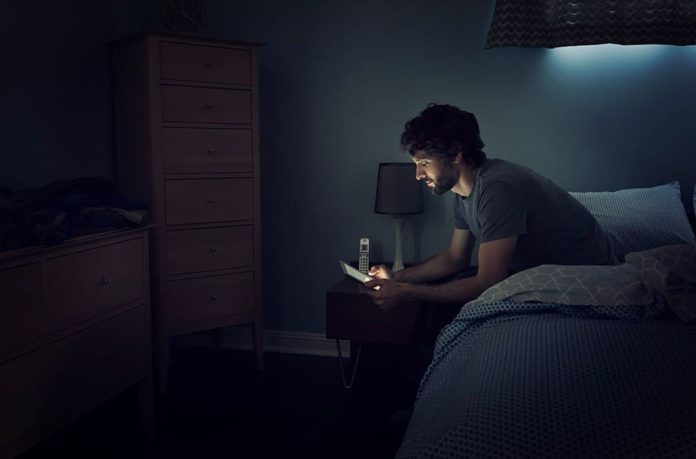New Northwestern Medicine research of older men and women aged 63 to 84 found that individuals who were exposed to any level of light while sleeping at night were considerably more likely to be obese, have high blood pressure, and have diabetes than adults who were not exposed to any light at all.
Over the course of seven days, light exposure was assessed using a wrist-worn device.
This is a real-world (rather than an experimental) study that shows that any light exposure at night is associated with increased obesity, high blood pressure (known as hypertension), and diabetes in older persons.
The findings of the study were published today in the journal SLEEP.
“Whether it be from one’s smartphone, leaving a TV on overnight or light pollution in a big city,” says study corresponding author Dr. Minjee Kim, “we live among an abundant number amount of artificial sources of light that are available 24 hours of a day.” The author adds: “older adults already are at higher risk for diabetes and cardiovascular disease, so we wanted to see if there was a difference in frequencies of these diseases related to light exposure at night .”
The team was surprised to find out that Less than half of the 552 study participants experienced a daily five-hour dark period. Even during their five darkest hours of the day, which were typically in the middle of their nighttime slumber, the other participants were exposed to some light.
Because this was a cross-sectional study, researchers do not know whether obesity, diabetes, and hypertension-induced people sleep with a light on or whether the light contributed to the development of these disorders. With the light on, people with these conditions may be more prone to use the restroom in the middle of the night or for other purposes. Keeping a night light on can help prevent falls for someone who has diabetes-related foot numbness.
According to Dr. Phyllis Zee, chief of sleep medicine at Feinberg and a physician with Northwestern Medicine, “it’s important for people to avoid or minimize the amount of light exposure during sleep.”
Zee and colleagues are thinking of conducting intervention research to see if restoring the natural cycle of light and darkness has a positive impact on health outcomes like cognition.
Zee suggested the following advice for minimizing light exposure when sleeping:
- Don’t switch on the lights. If you must have a light on—something that older people may need for safety—make it dim and closer to the floor.
- Color is crucial. The brain is less stimulated by amber or red/orange light. Avoid using white or blue light, and keep it a far away from the individual who is sleeping.
- If you can’t regulate the external light, blackout shades or eye masks are a solid choice. Reposition your bed so that the outdoor light is not in your face.
The people who took part in the study were originally a part of the Chicago Heart Association Detection Project in Industry (CHA). This was a public health program and epidemiologic study that ran from 1967 to 1973.
Its goal was to find high-risk adults for heart disease in Chicago-area workplaces. The study includes a thorough analysis of the recognized heart disease risk factors.
Mice studies have also revealed that when animals are housed in continual light – rather than the normal day/night cycle – they cannot adequately digest glucose and gain weight when compared to a control group.
To examine this link directly in humans, another study researchers recruited 19 healthy volunteers, held them in the lab under controlled settings for four days, and fed them the same meal.
They were all kept in the dim light while awake for the first two days. On the third day, participants were randomly divided into two groups and exposed to two different times of strong, blue-enriched light for three hours each.
The researchers discovered that exposure to bright light increased the body’s resistance to insulin, which meant that participants’ ability to remove glucose from their bloodstream decreased when exposed to bright light for a short period of time compared to when they were maintained in dim light.
Especially at night, exposure to strong light was associated with greater peak blood glucose levels. That’s a serious concern because, over time, elevated blood sugar levels are linked to a higher risk of developing diabetes and can also cause people to acquire weight and body fat.
Ivy Cheung, one of the researchers, claimed that the results “show that insulin was unable to acutely bring glucose levels back to a baseline level following a meal with bright light exposure in the evening.”
More research is required to confirm the findings because these results are based on limited sample size.
The researchers were unable to determine why light exposure was having this effect, but their findings do raise the possibility that our actions, such as checking our phones on full brightness at night, may be interfering with our brains. According to Cheung, the study’s findings “emphasize that our lighting environment impacts our health outcomes.”
However, there is a silver lining, since we now know that light exposure may be used to regulate metabolisms. Whether for good or bad.
Image Credit: Getty
You were reading: Light At Night Time Can Severely Mess With Your Metabolism, New Study Finds
